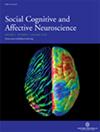自闭症儿童观看社交动画时的认知和情感共鸣网络互动受到干扰
IF 3.1
2区 医学
Q2 NEUROSCIENCES
引用次数: 0
摘要
移情可分为认知移情(CE)和情感移情(AE)两个核心部分,由不同的神经网络介导。共情缺失是自闭症谱系病(ASC)的一个核心特征,但目前还不清楚这种缺失是仅仅由于共情网络内部的紊乱还是认知共情网络和情感共情网络之间的功能整合紊乱所致。为了解决这个问题,我们使用近红外光谱仪测量了自闭症儿童(4-8 岁,n = 31)和匹配的典型发育(TD)儿童(n = 26)在播放唤起共情和情感共鸣的动画故事时共情网络内部和之间的功能连接(FC)模式。此外,还分别使用移情商数/系统化商数(EQ/SQ)和社会反应量表(SRS)对移情和社会交流能力进行了评估。结果显示,自闭症儿童AE网络中的FC在不同条件下与TD组没有差异;但ASC组在CE条件下CE网络中的FC较弱,在处理AE信息时网络间的FC也较弱,后者与ASC的EQ评分呈负相关。ASC的移情缺陷可能与AE条件下CE和AE网络活动的异常整合有关。本文章由计算机程序翻译,如有差异,请以英文原文为准。
Disrupted cognitive and affective empathy network interactions in autistic children viewing social animation
Empathy can be divided into two core components, cognitive empathy (CE) and affective empathy (AE), mediated by distinct neural networks. Deficient empathy is a central feature of autism spectrum conditions (ASC), but it is unclear if this deficit results from disruption solely within empathy networks or from disrupted functional integration between cognitive and affective empathy networks. To address this issue, we measured functional connectivity (FC) patterns both within and between empathy networks in autistic children (4–8 years, n = 31) and matched typically developing (TD) children (n = 26) using near-infrared spectroscopy during presentation of an animated story evoking CE and AE. Empathy and social communication ability were also assessed using the Empathy Quotient/Systemizing Quotient (EQ/SQ) and Social Responsiveness Scale (SRS), respectively. The results showed that the FC in the AE network of autistic children did not differ from the TD group across conditions; however, ASC group showed weaker FC in the CE network under the CE condition and weaker FC between networks when processing AE information, the latter of which was negatively correlated with EQ scores in ASC. The empathy defect in ASC may involve abnormal integration of CE and AE network activities under AE condition.
求助全文
通过发布文献求助,成功后即可免费获取论文全文。
去求助
来源期刊
CiteScore
6.80
自引率
4.80%
发文量
62
审稿时长
4-8 weeks
期刊介绍:
SCAN will consider research that uses neuroimaging (fMRI, MRI, PET, EEG, MEG), neuropsychological patient studies, animal lesion studies, single-cell recording, pharmacological perturbation, and transcranial magnetic stimulation. SCAN will also consider submissions that examine the mediational role of neural processes in linking social phenomena to physiological, neuroendocrine, immunological, developmental, and genetic processes. Additionally, SCAN will publish papers that address issues of mental and physical health as they relate to social and affective processes (e.g., autism, anxiety disorders, depression, stress, effects of child rearing) as long as cognitive neuroscience methods are used.

 求助内容:
求助内容: 应助结果提醒方式:
应助结果提醒方式:


